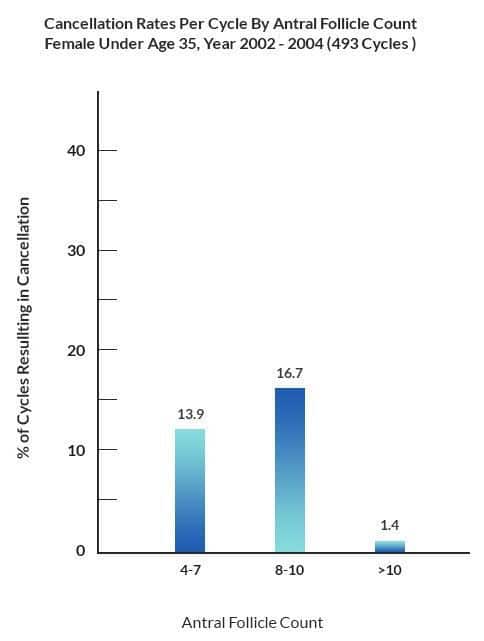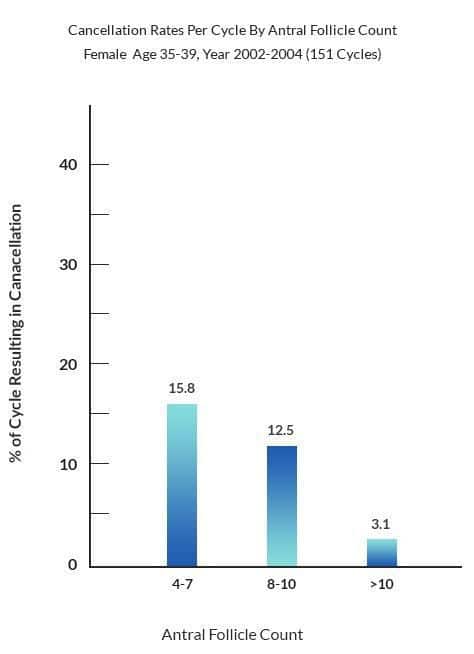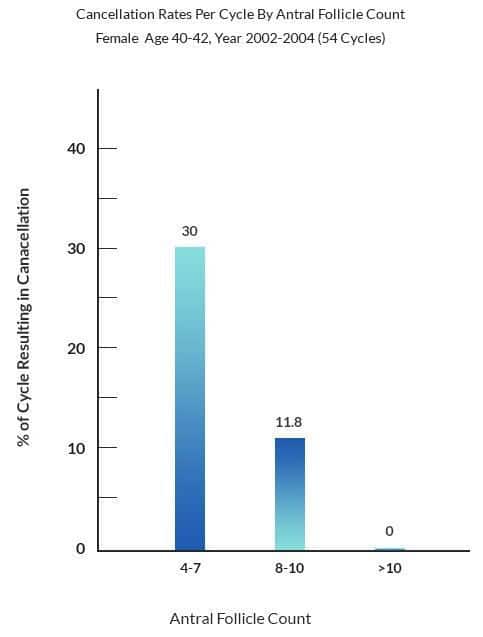Cancellation of IVF Cycles for Poor Ovarian Follicle Response – Not Proceeding With an Egg Retrieval Procedure
All IVF programs have criteria for cancellation of stimulation cycles that do not produce an adequate number of follicles to go through with egg retrieval procedure and in vitro fertilization. We use the same cancellation criteria for all IVF stimulations including patients using the “guarantee” pricing option for IVF, as well as those using the “traditional” (non-guarantee) IVF pricing option.
How many follicles are needed to do IVF treatment and proceed with the egg retrieval procedure?
Our criteria for cancellation are very objective:
- The stimulation must result in a minimum of 3 mature (or close to mature) follicles (we consider follicles to be mature if they are 16-20mm in average diameter on the day of HCG).
- Alternatively, if there are 2 follicles 16-20mm and at least 2 more that are 13-15mm, we can proceed to the egg retrieval.
We know that all you want is to have a baby and we want the same thing. There is only one reason that we cancel IVF stimulations for poor response: Delivery rates from IVF cycles when there are less than 3 mature size follicles present on ultrasound are much lower than with at least 4 mature follicles. We consider this to be the best “break-point” for deciding whether to proceed with egg retrieval – or cancel the cycle.
This is considering that:
- The IVF process has some medical risks involved
- The substantial additional economic costs of proceeding with the egg retrieval, fertilization, embryo culture, etc.
Unfortunately, when only a few follicles develop in response to the ovarian stimulation, there is usually, but not always a problem with egg quantity (sometimes also with egg quality). In other words, we get fewer eggs and they are sometimes also of lower quality as compared to the eggs obtained from women that respond normally to the ovarian stimulation.
For more information on number of eggs retrieved at IVF and IVF success and egg quality issues:
Egg numbers at IVF and success rates
Ovarian reserve issues: Egg quantity and egg quality
Prediction of probability of cancellation before starting the cycle
We can predict (fairly well) the ability of the woman’s ovaries to respond adequately to ovarian stimulation with 3 simple and inexpensive tests:
- Antral follicle counts – ultrasound test
- Anti-mullerian hormone level – blood test
- Day 3 FSH level – blood test
There are other general indicators of the risk of cancellation such as previous response to injectable gonadotropin stimulation, and female age.
Ready for an Appointment in the Chicago Area?
If you’re ready to explore treatment, contact the award-winning team at AFCC.
Find a Prelude Fertility Clinic Location Near You
The Prelude Network is the fastest-growing network of fertility centers in North America.
The relationship between antral follicle counts, female age, and risk of IVF cycle cancellation
IVF cancellation rates by antral count, female under age 35
Ivf cancellation rates by antral follicle counts and female age
IVF cancellation rates by antral count, female 35-39
ivf cancellation female age 40
IVF cancellation rates by antral count, female 40-42
All data and graphs are from unpublished data from our IVF program
IVF cycle cancellation rates increase with increasing female age and with decreasing antral follicle counts (they are independent risk factors for cancellation).
Occasionally, we might cancel an IVF cycle because of overstimulation. In these cases the ovaries are making too many follicles and too much estrogen and other hormones and growth factors. Canceling for overstimultion is very rare in our program now due to careful utilization of a Lupron trigger for very high responding women.
There can be some potentially serious health risks for the woman from severe ovarian hyperstimulation syndrome if the HCG injection is given and the cycle completed when the ovarian response to stimulation is very high.
If the ovarian stimulation dosing process is handled very carefully by the physician, cycle cancellation for over-response should be rare, particularly since we can use the Lupron trigger.
Our charges for canceled cycles
If the cycle is canceled before the egg retrieval, the cost for the cycle is $700 (cycle management fee) plus $75 per blood assay performed and $250 per ultrasound performed.




